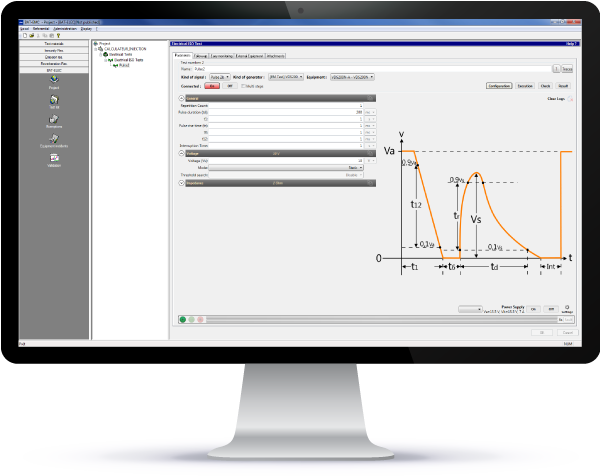Transient test automation software
BAT-ELEC
BAT-ELEC was developed by NEXIO to help our customers meet the new challenges posed by constantly evolving standards. NEXIO has developed BAT-ELEC, the only software compatible with all test generator manufactures and for all standards (automotive, commercial electronics, etc.).

Features
Compatible drivers
On request
Examples :
- HAEFELY
- EMTEST
- TESEQ
- EMC PARTNER
- Hilo
- Schlöder
- etc.
Assistance
- Experienced and specialized technical support
- Adapting to changing standards
- Drivers development
Applicable standards
- Automotive: ISO 16750-2 / ISO 7637-2
- Commercial electronics: IEC 61000-4-4 / IEC 61000-4-5/ IEC 61000-4-11 / IEC 61000-4-12
Transient test automation software
To assist our customers in adressing the new challenges posed by constantly evolving standards, NEXIO has developed BAT-ELEC, the only software compatible with all brands of test generator and for all standards (automotive, commercial electronics, etc.).
Electromagnetic immunity testing (EMC)
Burst, Surge and Transient tests are electromagnetic immunity (EMC) tests used to assess the robustness of electrical and electronic equipment against various electromagnetic disturbances. Here’s an overview of each of these tests:
Burst (or EFT/BurstElectrical Fast Transient/Burst) focuses on rapid, repetitive disturbances caused by electrical switching, such as the activation and deactivation of relays or switches.
The main features are :
- Frequency Short pulses, generally in the nanosecond to microsecond range.
- Amplitude Up to a few kilovolts.
- Distribution High-frequency pulse train, often applied to power and signal lines.
Objective To assess a device’s ability to tolerate rapid disturbances without malfunction or deterioration.
Surge (or overvoltage) tests the ability of devices to withstand high voltage pulses that are relatively long in duration compared to bursts.
These surges can be caused by events such as lightning strikes or high-power switching.
- Frequency Longer pulses, on the order of microseconds to milliseconds.
- Amplitude Higher than bursts, up to several kilovolts.
- Source External events such as lightning strikes or major switching operations on the power grid.
Objective To check that the equipment can survive significant power surges without suffering damage or malfunction.
The tests Transient tests cover a wide range of transient electromagnetic disturbances which can include both bursts and surges, but also other forms of transients such as electromagnetic pulses (EMP) or electrostatic discharges (ESD).
- Amplitude and duration Varies according to the specific type of transient, covering a wider range than specific burst or surge tests.
- Source Can include internal and external events, such as power interruptions, electrostatic discharges and electromagnetic pulses.
Objective To ensure overall immunity of equipment against various types of electromagnetic transients.
Tests are generally carried out in the laboratory using specific disturbance generators that simulate real-life conditions.
International standards such as IEC 61000-4-4 (for bursts), IEC 61000-4-5 (for surges) and other IEC 61000 standards are often followed to ensure a consistent, reproducible methodology.
These tests are crucial to ensure that electrical and electronic devices can operate reliably in environments where electromagnetic interference is present.
This ensures the safety, performance and durability of equipment under real-life conditions.
In summary, Burst, Surge and Transient tests are key elements of EMC evaluation, each targeting specific types of electromagnetic disturbance to ensure that equipment is robust and reliable in electromagnetically disturbed environments.
These tests are carried out with several instruments from different brands, each requiring specific software, and these brands do not have software development as their core business.

BAT-ELEC user benefits
- 1 software for all your equipment
- 1 software for all standards
- 1 software package for all your electrical EMC tests
- Advanced EUT monitoring and control functions
- Automated reporting
- A team of specialists at your service
- Signal verification using oscilloscopes, and automatic screenshots sent directly to the report
BAT Webinars replay
Discover all our replay webinars dedicated to the BAT range